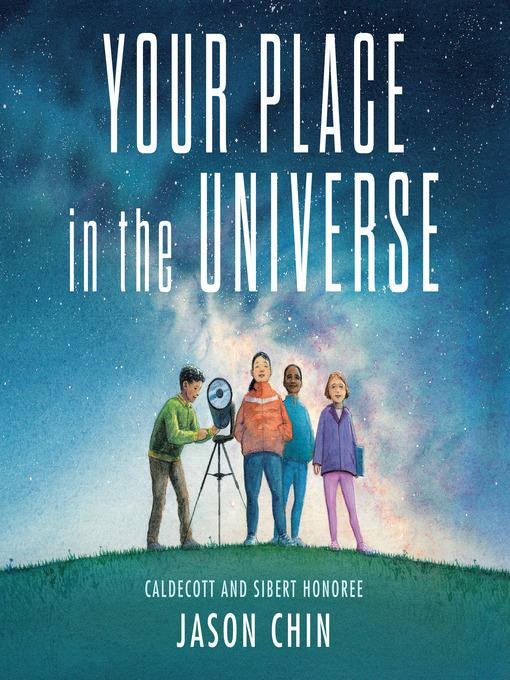
Your Place in the Universe
فرمت کتاب
ebook
تاریخ انتشار
2020
Reading Level
4
ATOS
5.7
Interest Level
K-3(LG)
نویسنده
Jason Chinناشر
Holiday Houseشابک
9780823448784
کتاب های مرتبط
- اطلاعات
- نقد و بررسی
- دیدگاه کاربران
نقد و بررسی

May 1, 2020
From a Caldecott and Sibert honoree, an invitation to take a mind-expanding journey from the surface of our planet to the furthest reaches of the observable cosmos. Though Chin's assumption that we are even capable of understanding the scope of the universe is quixotic at best, he does effectively lead viewers on a journey that captures a sense of its scale. Following the model of Kees Boeke's classic Cosmic View: The Universe in Forty Jumps (1957), he starts with four 8-year-old sky watchers of average height (and different racial presentations). They peer into a telescope and then are comically startled by the sudden arrival of an ostrich that is twice as tall...and then a giraffe that is over twice as tall as that...and going onward and upward, with ellipses at each page turn connecting the stages, past our atmosphere and solar system to the cosmic web of galactic superclusters. As he goes, precisely drawn earthly figures and features in the expansive illustrations give way to ever smaller celestial bodies and finally to glimmering swirls of distant lights against gulfs of deep black before ultimately returning to his starting place. A closing recap adds smaller images and additional details. Accompanying the spare narrative, valuable side notes supply specific lengths or distances and define their units of measure, accurately explain astronomical phenomena, and close with the provocative observation that "the observable universe is centered on us, but we are not in the center of the entire universe." A stimulating outing to the furthest reaches of our knowledge, certain to inspire deep thoughts. (afterword, websites, further reading) (Informational picture book. 8-10)
COPYRIGHT(2020) Kirkus Reviews, ALL RIGHTS RESERVED.

Starred review from July 1, 2020
PreS-Gr 4-This picture book helps children and adults conceptualize size, space, and distance. The narrative begins with a group of curious eight-year-olds who are peering through a telescope. The text compares the kids to larger and more distant items, including a book, a giraffe, trees, and buildings. The illustrations include the objects' scale and height in feet and meters. Each picture shows the item compared to the previous example. For instance, when the text explains the size relationship between the world's tallest buildings and the world's highest mountains, Chin's extraordinary artwork shows how tiny the buildings are compared to the breathtaking mountains. The book keeps zooming out through the Milky Way and through galaxy clusters until readers are viewing the entire universe. Back matter features an author's note, information about the age of the universe and the illustrations, and print and online resources. People of all ages will want to pore over the captivating artwork and think about the relationship between size and space. VERDICT A fascinating book that is as informative as it is marvelously absorbing. A must-have for any collection.-Debbie Tanner, S D Spady Montessori Elem., FL
Copyright 2020 School Library Journal, LLC Used with permission.

July 1, 2020
Grades 2-5 The illustrator of Nine Months: Before a Baby Is Born (2019) here introduces the concepts of size, scale, and distance to a young audience. Beginning with the book the reader is holding (approximately 10 inches high), Chin moves incrementally up in scale to a child, an ostrich, and a giraffe, eventually quantifying distances from the Earth to the Milky Way, the cosmic web, and the observable universe. Each full-bleed spread contains brief text, digitally enhanced watercolor-and-gouache illustrations, and a variety of captions and sidebars that further elucidate these big ideas. Many spreads also depict items from previous examples, offering reference to the sizes and scales portrayed. Blue hues predominate (particularly for the cosmic spreads), with green, purple, and orange used as accents. As always, Chin is a stickler for details (the book was vetted by two Harvard astrophysicists); all illustrations are shown to scale with the exception of one or two final entities that would otherwise spread beyond the page. A worthy addition to STEM literature; concluded with generous back matter.(Reprinted with permission of Booklist, copyright 2020, American Library Association.)

Starred review from August 10, 2020
This dizzyingly powerful exploration of comparative scale starts with an inclusive group of eight-year-old children who are “about five times as tall as this book, but only half as tall as... this ostrich,” which is itself “taller than two eight-year-olds standing on each other’s shoulders.” Page-turn cliffhangers build a pleasing buzz of suspense as Caldecott Honoree Chin (Grand Canyon) adroitly guides readers from ostriches to redwood trees, past skyscrapers and Mount Everest, through Earth’s layered atmosphere to the moon, and beyond the solar system to the edges of the observable universe. Brief asides offer crystalline explanations of supplemental information, including units of measurement from inches to light-years (“One foot is equal to 12 inches. Feet are useful for measuring things that are taller than humans, such as ostriches and giraffes”) and concepts such as orbits, the speed of light, and the limitations of human perception from one’s place in an enormous universe. Chin’s realistic watercolor and gouache illustrations render awestruck children and cosmic shimmer with inimitable skill, and a magnificent spread comparing Mount Everest’s mass to that of human-built structures is likely to draw gasps. Extensive back matter centers scale and astronomical concepts. Ages 4–8.

























دیدگاه کاربران